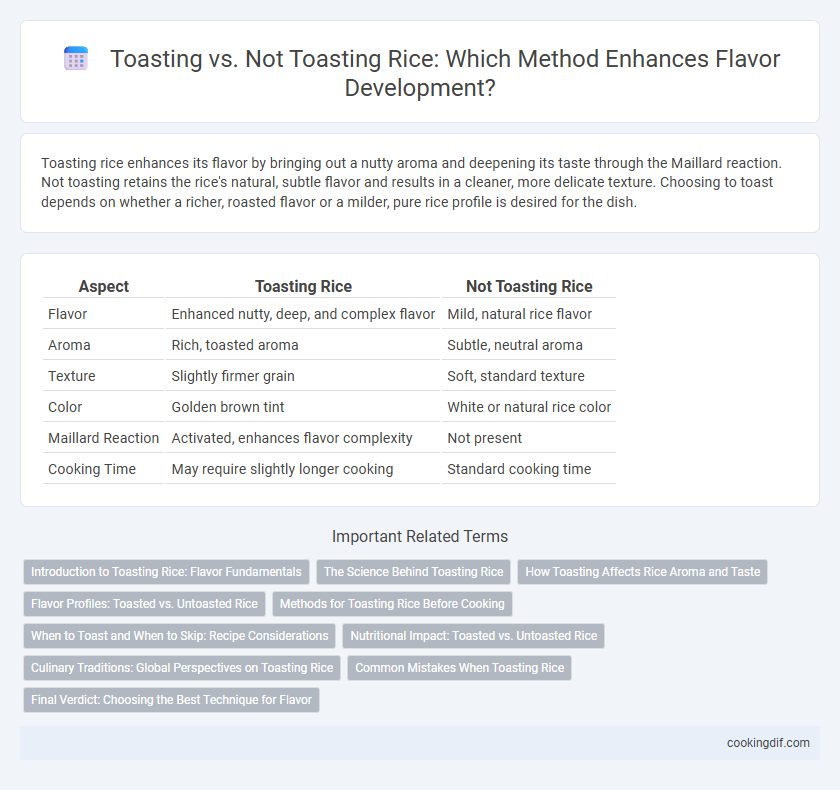Toasting rice enhances its flavor by bringing out a nutty aroma and deepening its taste through the Maillard reaction. Not toasting retains the rice's natural, subtle flavor and results in a cleaner, more delicate texture. Choosing to toast depends on whether a richer, roasted flavor or a milder, pure rice profile is desired for the dish.
Table of Comparison
| Aspect | Toasting Rice | Not Toasting Rice |
|---|---|---|
| Flavor | Enhanced nutty, deep, and complex flavor | Mild, natural rice flavor |
| Aroma | Rich, toasted aroma | Subtle, neutral aroma |
| Texture | Slightly firmer grain | Soft, standard texture |
| Color | Golden brown tint | White or natural rice color |
| Maillard Reaction | Activated, enhances flavor complexity | Not present |
| Cooking Time | May require slightly longer cooking | Standard cooking time |
Introduction to Toasting Rice: Flavor Fundamentals
Toasting rice enhances its flavor profile by inducing Maillard reactions that develop nutty, aromatic notes and deepen color. The heat causes starches to slightly caramelize while releasing essential oils, resulting in a richer, more complex taste compared to untoasted rice. This fundamental technique is commonly used in pilafs and risottos to elevate sensory appeal and texture.
The Science Behind Toasting Rice
Toasting rice enhances flavor development by initiating the Maillard reaction, where amino acids and reducing sugars react under heat, creating complex aromatic compounds. This process alters the rice's starch structure, improving its texture and imparting a nutty, toasted aroma that intensifies during cooking. Not toasting rice preserves its natural, subtle flavor but lacks the depth and richness produced by these chemical transformations.
How Toasting Affects Rice Aroma and Taste
Toasting rice before cooking intensifies its nutty aroma and deepens the flavor profile by promoting Maillard reactions and releasing toasted, caramelized notes. The heat transforms the starch structure, creating a slightly firmer texture and enhancing the overall sensory experience. Untoasted rice retains a more neutral, milder flavor, allowing other ingredients to dominate the dish's taste.
Flavor Profiles: Toasted vs. Untoasted Rice
Toasted rice develops deeper, nutty, and slightly smoky flavor profiles due to the Maillard reaction during toasting, enhancing the complexity of dishes like Korean nurungji or Thai khao khua. Untoasted rice maintains a cleaner, lighter, and more neutral flavor, allowing the natural sweetness and texture of the grain to stand out in recipes such as sushi or risotto. The choice between toasting and not toasting rice significantly impacts the aromatic intensity and taste depth in culinary applications.
Methods for Toasting Rice Before Cooking
Toasting rice before cooking enhances nutty, complex flavors by lightly browning the grains in oil or butter over medium heat for 3-5 minutes until aromatic. This method reduces moisture content, promoting a firmer texture and preventing clumping during cooking. Skipping toasting retains the rice's natural mildness but misses out on the depth and richness developed through Maillard reactions.
When to Toast and When to Skip: Recipe Considerations
Toasting rice enhances its nutty aroma and adds depth to dishes like pilafs and risottos where a rich, toasted flavor is desired. Skip toasting for recipes such as sushi or plain steamed rice to preserve the delicate, natural taste and soft texture. Consider cooking method and final dish flavor profile when deciding whether to toast the rice, as toasting complements recipes requiring robust flavor but can overpower subtle preparations.
Nutritional Impact: Toasted vs. Untoasted Rice
Toasting rice enhances its flavor by initiating the Maillard reaction, which develops nutty and complex aromatic notes without significantly altering its macronutrient composition. Nutritionally, toasted rice retains most vitamins and minerals, though slight reductions in heat-sensitive nutrients like some B vitamins may occur. Untoasted rice preserves a higher level of these heat-sensitive nutrients but lacks the enhanced flavor profile achieved through toasting.
Culinary Traditions: Global Perspectives on Toasting Rice
Toasting rice enhances its nutty aroma and deepens flavor through Maillard reactions, a technique prevalent in Middle Eastern pilafs and Mediterranean risottos where browned grains enrich the dish's complexity. East Asian cuisines, by contrast, often forgo toasting to preserve the rice's delicate, natural fragrance and tender texture, highlighting the grain's purity in sushi and steamed rice preparations. The choice to toast or not reflects regional culinary values, balancing texture and flavor to complement diverse dishes worldwide.
Common Mistakes When Toasting Rice
Toasting rice enhances its nutty aroma and improves texture by releasing natural oils, but common mistakes include overheating, which leads to burnt grains and bitter flavors, and uneven toasting due to insufficient stirring. Another frequent error is using high heat too early, causing the rice to cook prematurely rather than developing a balanced, toasted flavor. Properly controlled toasting requires medium heat and continuous stirring to achieve optimal flavor development without compromising the rice's integrity.
Final Verdict: Choosing the Best Technique for Flavor
Toasting rice enhances its nutty aroma and deepens flavor complexity by initiating Maillard reactions before cooking, resulting in a richer, more robust taste profile. Untoasted rice retains a cleaner, milder flavor ideal for delicate dishes where subtlety is preferred. For those seeking pronounced, layered flavors, toasting is the optimal technique, while avoiding toasting suits recipes requiring gentle, neutral rice characteristics.
Toasting vs Not Toasting for flavor development Infographic

 cookingdif.com
cookingdif.com